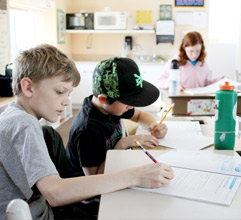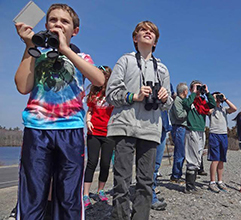Seventh Grade



The Middle School program offers a bridge from Elementary School to High School. The Middle School has its own wing in the Middle Building, and takes most of its classes in that wing, but interaction with younger students continues in formal (Sharing Assemblies, After School Enrichment, reading buddies) and informal (recess) settings.
Seventh graders take yearlong classes in English, Math, Life Science, Ancient History and Study Skills, and one trimester each of Art, Drama and Spanish.
English focuses on a study of literature that is both classic and contemporary; we read and discuss works by authors ranging from Shakespeare to Jason Reynolds. Emphasis is placed upon practicing editing skills and vocabulary enrichment. The major theme of all reading and writing assignments is perseverance.
The Math curriculum presents important concepts in the context of engaging problems, and also provides personalized, differentiated skills practice. Students will learn to: analyze proportional relationships and use them to solve real-world and mathematical problems; apply and extend previous understandings of operations with fractions; use properties of operations to generate equivalent expressions; draw, construct and describe geometrical figures, and describe the relationships between them; use random sampling to draw inferences about a population; draw informal comparative inferences about two populations; investigate chance processes and develop, use and evaluate probability models. Students will also solve real-life and mathematical problems using numerical and algebraic expressions and equations, as well as those involving angle measure, area, surface area and volume.
Life Science studies living things and how they interact with the world around us. Topics covered include: molecular and cellular processes and how they contribute to the life, growth and development of organisms; interactions, energy and dynamics of ecosystems; patterns of inheritance and variation of traits through time and among populations; and how the mechanism of natural selection contributes to the diversity of life on Earth and explains the unity of past and present day life forms. Students also evaluate, design and carry out experiments using controls, variables, scientific method, measurement bias, sampling bias, proper ethics and safe laboratory practices.
Social Studies takes an interdisciplinary approach, incorporating sociological, philosophical and anthropological perspectives to understanding the past. The main objective of the course is to make students aware of the fact that they "live in history, that their present is a product of their past, and that their future is an outcome of the present." The following topics are covered: Prehistoric Times, the River Civilizations (Mesopotamia, Egypt, Harappa, Shang/Zhou), the Phoenicians and Hebrews, the Minoans, Ancient India, Ancient Western Africa, Ancient Meso- and South America.
The goal of Study Skills/Technology is to enable students to take control of their own learning through developing good study habits and learning to take advantage of areas of strength while working to improve upon areas of difficulty. Enhancing skills in academic technology and research is an integral component of this program.
Spanish uses the TPRS (Teaching Proficiency through Reading and Storytelling) method of instruction, which immerses students in hearing the language in a relaxed and fun setting; students experience the language rather than learn about it in English.
Art includes work in a variety of media: drawing, painting, sculpture, printmaking and mixed media. Assignments are designed to develop skills and challenge students to think and solve problems. Students are encouraged to get ideas and inspiration from art appreciation that will introduce past masters and present-day artists.
Drama begins as an acting class, in which concepts, terms and techniques are introduced, practiced through exercises, and reflected on during critiques. The class determines by consensus the nature of their final project, which culminates in an evening performance. The remainder of the trimester consists of rehearsals, coaching and critiquing.
In Health Education, our goals are to develop a caring community and to encourage choices that promote physical wellness, personal safety and positive self-esteem. The focus will be on the seven dimensions of health, with an emphasis on interpersonal relationships and communication skills. Students build an age-appropriate foundation of knowledge that supports healthy choices and healthy living.
